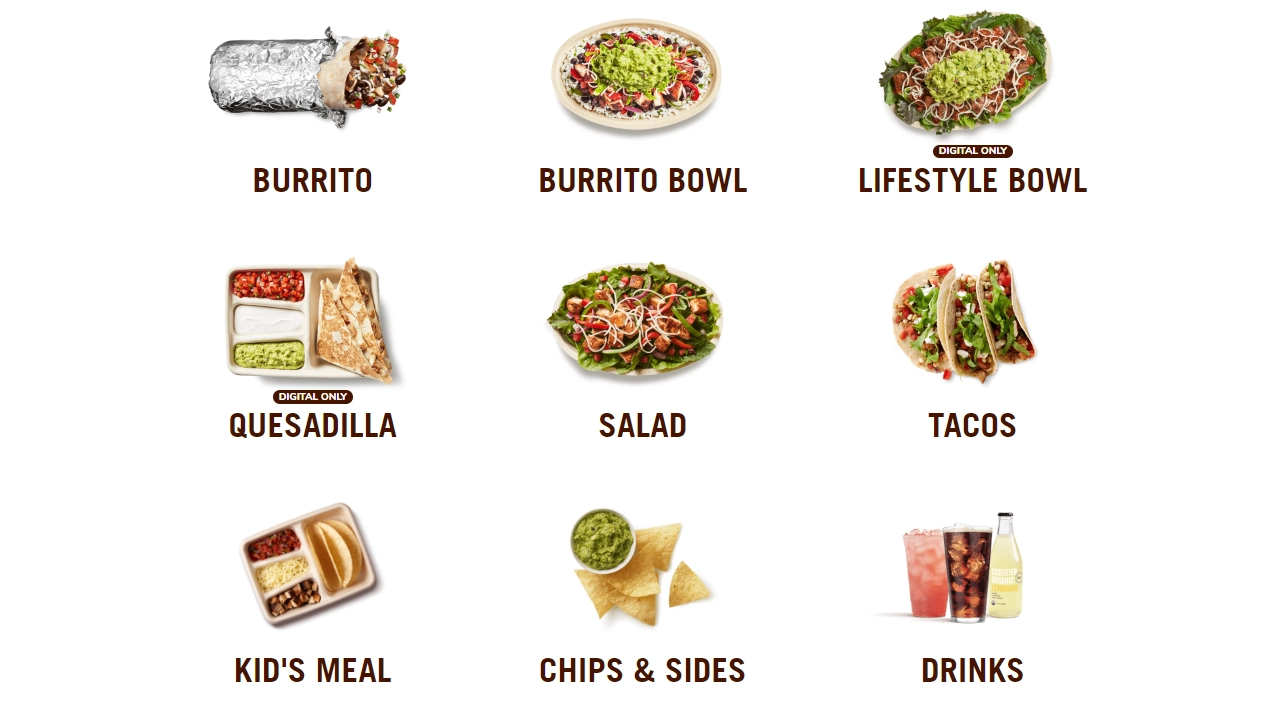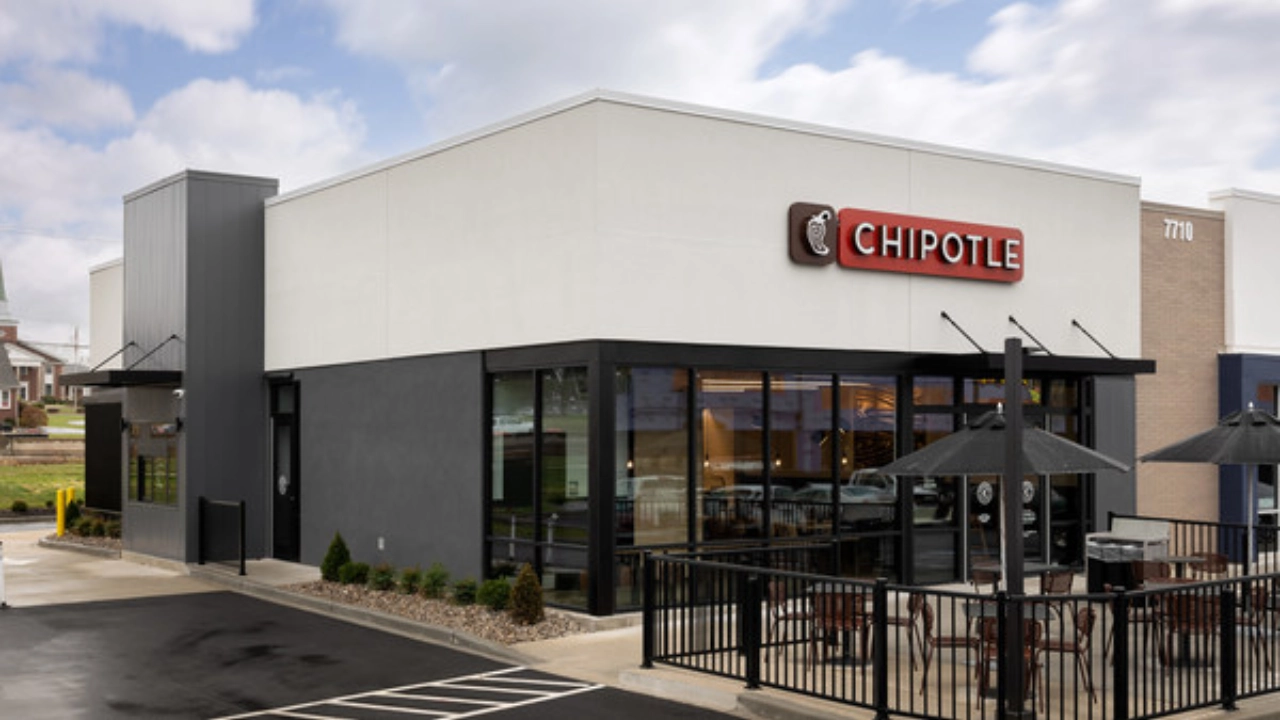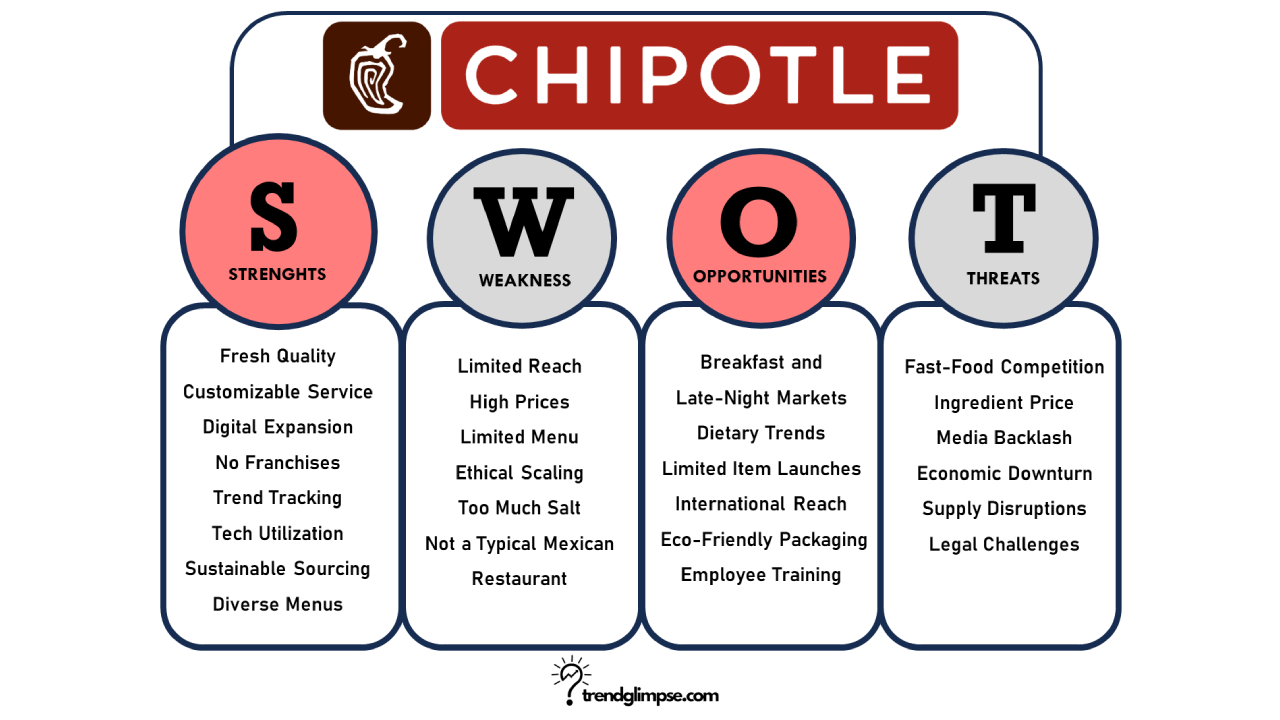An Overview of Chipotle
Chipotle has become a go-to for customized Tex-Mex style bowls and burritos over the past few decades. This fast-casual restaurant chain seems to be everywhere these days. Step into one of their 3,283 locations across the U.S., Canada, U.K., France, and Germany and you’ll usually see a line of fans waiting to get their fix of Chipotle’s signature cilantro-lime rice, burritos, tacos, and bowls.
Headquarters: Newport Beach, California, United States
Industry: Restaurant Chain, Fast casual
Current CEO: Brian Niccol
Annual Revenue [2023]: US$ 8.6 Billion
Employee Count: ~110,000
The company cooks up naturally raised chicken, steak, carnitas (pork), Barbacoa (beef), and Sofritas (organic tofu) right there in front of you as you move down the assembly line picking your perfect combination of ingredients. On an average day, a Chipotle restaurant serves approximately 750,000 customers. The number of customers per day can vary depending on the location and time of the day.
In 2022, total revenue increased 14.4% to $8.6 billion, and comparable restaurant sales increased 8.0%. In-restaurant sales increased 26.4%, while digital sales represented 39.4% of food and beverage revenue.
Burritos, Bowls, Tacos, Quesadillas, Salads, Beverages, Chips and Guacamole, Catering, Online Ordering and Delivery
Areas Chipotle Serves
Canada, France, Germany, United Kingdom, United States
Competitiors of Chipotle
Qdoba Mexican Eats, Moe’s Southwest Grill, Baja Fresh Mexican Grill, Rubio’s Coastal Grill, Taco Bell, Panera Bread, Burger King, KFC, Chick-fil-A, Domino’s Pizza, Pizza Hut, Starbucks, Wendy’s, Shake Shack
Chipotle seems to appeal to health-conscious millennials with majority of sales coming from Gen Z and millennials. The company has worked hard to recover from food safety issues in 2015 by focusing on sourcing responsibly raised meats and eliminating artificial flavors and colors. They’ve also introduced new initiatives like online ordering for pick up and delivery. This allows busy, tech-savvy generations to customize their meals without waiting in line at the restaurant.
Let’s take a look at Chipotle’s strengths, weaknesses, opportunities and threats, also known as a SWOT analysis. By examining these internal and external factors, we can better understand Chipotle’s current situation and future potential.
STRENGTHS
High-quality, fresh ingredients in menu items
Chipotle lists all 53 ingredients used to make items on their menu, committing to real food. They describe each ingredient and which menu items contain them. Some examples are avocados in guacamole, cilantro in salsas, and lime juice that marinates meats. This transparency allows customers to see what goes into each dish.
Chipotle employs an open kitchen concept, allowing customers to see how their food is prepared. This ensures that each customer gets exactly what they desire, with fresh ingredients prepared right in front of them.
While McDonald’s relies on pre-prepared items for speed, like using pre frozen burger patties and partially cooked fries. Chipotle’s success hinges on daily, in-house preparation of fresh ingredients.

Expanding digital presence by special offers
Chipotle is making a push towards digital and sustainable business practices, as seen by its commitment to make food more accessible through technology innovations. For example, it has made certain menu items like the Quesadilla and Guenther Steiner Burrito digital-only offerings on its app and website for limited periods of time. Chipotle also utilizes special discounts and loyalty programs to encourage consumers to use its digital platforms.
Recently, Chipotle opened its 500th Chipotlane, a digital order drive-thru pick-up lane, further emphasizing convenience through technology. In Q2, 38% of Chipotle’s total food and beverage revenue already came from digital sales. Of the 47 new restaurants Chipotle opened, 40 included a Chipotlane, highlighting the expansion of digital order options.
Chipotle has no franchises
Chipotle believes that franchising would compromise its ability to maintain its high standards for food quality, food preparation, and employee culture. Instead of franchising, Chipotle has grown by raising capital from investors and opening new restaurants itself.
Chipotle closely monitors the efficiency of its assembly lines and speed of customer queues by reviewing security footage. This allows them to ensure employees are performing assigned duties. Additionally, Chipotle wants tight control over food sourcing without potential pressure from franchises.
Keeping up with the trends
Chipotle has launched a new line of Lifestyle Bowls that are inspired by Gen Z and Millennial wellness trends. The bowls are designed to be convenient and delicious, and they cater to a variety of dietary needs. Chipotle is also launching a wellness-inspired AR Lens on Snapchat to encourage fans to maintain healthy habits. Chipotle is piloting two new technologies to enhance its employee and guest experience
Chipotle had launched a new Fajita Quesadilla on March 2, 2023, inspired by a viral TikTok trend. The Fajita Quesadilla is a digital-only menu item, so it can only be ordered online or on the Chipotle app. The Fajita Quesadilla will be available for a limited time only. In March, Chipotle launched the Fajita Quesadilla in March, a new menu item inspired by a viral TikTok trend. The introduction of this quesadilla nearly doubled the sales of Chipotle’s existing quesadilla offerings at the time of launch.
Utilizing AI and advanced tech
Chipotle is testing a new automated digital makeline in collaboration with Hyphen, a foodservice platform designed to help restaurant owners and operators automate kitchen operations. The new makeline can create bowls and salads, while Chipotle employees operate the top makeline to make burritos, tacos, and quesadillas. The makeline is expected to free up more time for Chipotle employees to service the front makeline and deliver exceptional hospitality, while simultaneously increasing capacity for digital orders during peak periods.
Chipotle is also testing its autonomous kitchen assistant, CHIPPY, which makes tortilla chips using culinary traditions and artificial intelligence. CHIPPY is currently installed in one restaurant in Fountain Valley, CA, and will start cooking chips for guests next month.
Commitment to sustainable and locally-sourced ingredients
Chipotle Mexican Grill received an “A” grade in the Chain Reaction III Report and Scorecard, a ranking of the country’s largest fast food and fast casual restaurant companies based on their policies for antibiotic use in farm animals.
Chipotle is one of the top 10 fast-food chains that use the highest quality beef. The company sources its beef from animals raised without the routine use of antibiotics and no added hormones ever. It is also committed to only using responsibly raised meat with high animal welfare standards. Plus, the entire menu is completely free from all artificial colors, flavors, and preservatives.
Diverse menu options to cater to various dietary preferences
Chipotle offers many nutrient-rich, whole food ingredients and heavier, less nutritious choices, so the healthfulness of what’s in your bag is really up to you. To ensure you get the most nutrition from your meal, use the chain’s tools, including nutrition and allergy info, to customize meals based on your needs and goals.
Allergy-friendly options, Vegan and Vegetarian Alternatives as well as gluten free options. For gym bros and girlies you can use the Chipotle nutrition calculator to view the calorie content of each item you add to your meal.
You Might Also Like: Caterpillar SWOT Analysis
WEAKNESS
Limited international presence compared to competitors
Chipotle’s footprint is somewhat smaller when compared to some of its competitors. While you can find McDonald’s and other fast-food giants almost anywhere in the world, Chipotle’s international expansion has been slower.
This limited presence means that when you’re traveling abroad, you might not have the convenience of grabbing your favorite Chipotle burrito bowl. The familiarity and comfort of having Chipotle when you’re away from home might not always be an option.
High prices compared to some fast-food alternatives
While Chipotle offers a unique and high-quality dining experience, it’s also known for relatively higher prices compared to traditional fast-food alternatives. When you compare the cost of a Chipotle meal to a dollar menu item at a fast-food restaurant, you’ll find a noticeable difference. This price point can be a drawback for budget-conscious consumers or those looking for a quick, inexpensive meal.
Limited menu diversification compared to other restaurant chains
Chipotle has built its brand around a simple and straightforward menu that focuses on burritos, bowls, tacos, and a few other staples. While this simplicity is appreciated by many customers who value the quality and consistency of these offerings, it may not satisfy those seeking a more diverse range of options. Some restaurant chains offer a broader menu with a wider variety of dishes, including breakfast items, desserts, and seasonal specialties. Chipotle’s menu is relatively compact in comparison.
Maintaining “Food with Integrity” promise as the company grows
One of Chipotle’s core promises is serving “food with integrity,” which involves sourcing responsibly raised and high-quality ingredients. However, as the company expands and operates a large number of locations, maintaining this promise consistently can become a considerable challenge. Ensuring that all suppliers meet these stringent standards and that the quality is uniform across locations is not always easy, especially when you’re dealing with a large-scale operation.
Not your typical mexican restaurant
While Chipotle is renowned for its fresh, customizable Mexican-inspired fare, it is a fast-casual establishment. This means you won’t have the traditional sit-down Mexican restaurant experience with table service and an extensive margarita menu. If you’re looking for a leisurely, full-service dining experience with an array of Mexican dishes and cocktails, Chipotle won’t provide that ambiance.
Too much salt
While Chipotle’s menu is appreciated for its fresh ingredients, one criticism is that some menu items can contain high levels of salt. Excessive salt intake is a concern for many consumers due to its potential health risks, such as high blood pressure and cardiovascular issues. While salt is used to enhance flavor, some customers may find Chipotle’s dishes saltier than their preference or dietary needs. This can be a drawback for those who are conscious of their sodium intake or have specific dietary restrictions.
OPPORTUNITIES
Expansion into the breakfast and late-night markets
Imagine starting your day with a Chipotle breakfast burrito or satisfying those late-night cravings with a customizable burrito bowl. By extending their hours and offering a breakfast menu, Chipotle can cater to different customer needs.
For example, Chipotle can introduce a “Build Your Own Omelette” station during breakfast hours. Customers can choose from a variety of fresh ingredients like diced tomatoes, peppers, cheese, and have it cooked to order. At night, they could offer unique dessert burritos, with options like cinnamon sugar tortillas and sweet fillings.
Leveraging health-conscious and dietary trends
The health-conscious consumer trend is booming, and Chipotle can seize this opportunity by introducing more dietary options. For instance, they can expand their vegetarian and vegan choices, such as a delicious vegan sofritas bowl with plant-based protein, and create a specific menu for keto or gluten-free diets.
Exciting limited menu item launches
Chipotle is known for its limited menu, and this sparks excitement when new items are introduced. They could make this a regular event. For instance, introducing a rotating “Guest Chef Special” every season, where a renowned chef collaborates with Chipotle to craft a unique, limited-time dish. This keeps the buzz alive and maintains customer engagement.
Global expansion into new international markets
Chipotle’s popularity isn’t limited to the United States. They can expand internationally by identifying markets where their fresh, customizable approach can resonate. For example, opening locations in major cities in Europe and Asia could introduce Chipotle to a whole new global audience. They can create tailored menu innovations to cater to local preferences. in Japan, they might introduce a sushi-inspired bowl with fresh seafood, or in India, they could offer a spicy curry-infused burrito.
Focus on eco-Friendly packaging and sustainability initiatives
In today’s environmentally conscious world, sustainable practices are a big selling point. Chipotle can take a lead in this by reducing single-use plastics and offering reusable packaging options. They might even run promotions where customers get discounts for bringing their own containers or using eco-friendly packaging. Additionally, they could source more ingredients locally to reduce their carbon footprint.
Enhancing employee training and retention
Employee satisfaction is critical for a successful business. Offering more comprehensive training programs and career advancement opportunities can make Chipotle an employer of choice. For example, they can create a certification program for employees who excel in customer service, which not only motivates staff but also enhances the customer experience.

THREATS
Crowded marketplace as rivals compete for customers
Chipotle has faced significant competition from rivals in the fast-casual and fast-food industry. As more players enter the market, it’s increasingly challenging for them to stand out. For instance, in recent years, newcomers like Shake Shack and Blaze Pizza have garnered attention with innovative menu items and branding. Chipotle must continually innovate to stay competitive, whether it’s through menu expansion, technology enhancements, or store design.
Fluctuations in commodity prices for key ingredients
Chipotle relies heavily on ingredients like avocados and beef, which are vulnerable to price fluctuations due to factors like weather events or trade tariffs. In 2019, the US experienced an avocado shortage that caused prices to skyrocket. Such fluctuations can squeeze margins and impact the affordability of Chipotle’s offerings, potentially driving customers to competitors.
Negative publicity or social media backlash
In the age of social media, one tweet can launch a thousand problems. Remember when Chipotle had that E. coli scare in 2015? It was all over Twitter, Instagram, and Facebook. The negative buzz hit Chipotle hard. Today, a single incident can go viral, potentially causing damage to their reputation and sales. Staying vigilant about food safety and addressing customer concerns promptly is crucial to avoid further backlash.
Recession impacts restaurant industry as diners tighten belts
During economic downturns, consumers often tighten their budgets, and dining out becomes a discretionary expense. This can significantly impact Chipotle’s sales. For example, during the COVID-19 pandemic, restaurant traffic and revenues dropped substantially as people cut back on eating out due to financial uncertainties.
Supply chain disruptions due to natural disasters or geopolitical issues
Natural disasters or geopolitical conflicts can disrupt the supply chain, affecting Chipotle’s ability to source ingredients reliably. Hurricanes, for instance, can devastate agricultural regions, disrupting the supply of products like tomatoes and peppers. Similarly, trade disputes or border closures can impact the flow of essential ingredients.
Natural calamities or geopolitical conflicts disrupt supply networks globally
Legal issues can be costly and damaging to a company’s reputation. Chipotle has faced lawsuits related to foodborne illnesses and labor practices in the past. For example, they settled a class-action lawsuit in 2016 for alleged labor law violations. Such cases can result in financial penalties and tarnish the brand’s image, making it essential for Chipotle to maintain stringent quality control and labor practices.
Legal battles can be a restaurant’s worst nightmare. Chipotle has had its share of lawsuits, from foodborne illnesses to labor disputes. These courtroom skirmishes are not just about paying hefty settlements but also about preserving their good name. The last thing they want is a reputation smeared with accusations of poor food quality or unfair labor practices. So, they’ve got to maintain top-notch quality control and labor standards.
Closing thoughts
Overall, Chipotle has a lot going for it – strong brand recognition, high-quality ingredients, and an emphasis on sustainability and ethical sourcing. However, it needs to address public health scares and supplement its limited menu.
Looking ahead, focusing on food safety, supply chain traceability, and operational excellence will be key in restoring long-term consumer trust. Expanding the menu judiciously with exciting yet consistent options could help drive sales growth and retain customers. Doubling down on digital innovation and personalized customer experiences may enhance brand loyalty, especially with younger demographics.
If Chipotle can leverage its powerful ingredients and purpose-driven ethos while adapting nimbly to evolving consumer preferences, it is primed to recover its mystique as a beloved lifestyle brand rather than just another quick-service chain. Continued thoughtful but bold innovation, anchored in its brand values, will shape Chipotle’s future as a category leader.

I have always been fascinated by the inner workings of companies and industries. So I decided to study business to explore it more. My goal is to take all my research and turn it into cool stories that give people a better understanding of the business world.

